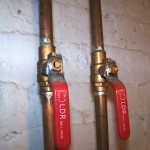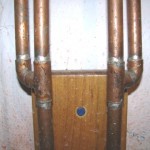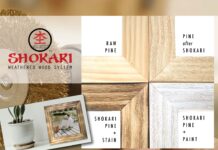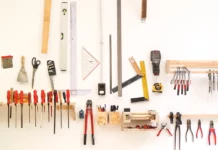When most people hear that they have to solder a pipe, they tend to get a little scared. Well, this is quite natural, because there is definitely a right way and a wrong way to solder pipes. This article will cover how to solder copper pipes, so you can feel very comfortable next time you need to use this trade. By the time you solder your next copper pipe, you will be proud to show off your work.
You might ask yourself, when would I every solder a copper pipe? Well, this isn’t an everyday occurrence unless you are a plumber. For everyone else, you would solder a pipe for a water heater, water softener or lots of other applications. It is one of those trades that is good to know when you need it.
You can also watch our video down below this article.
The items you will need for this job are:
- Tape Measure
- Copper Piping
- Copper Pipe Fittings
- Copper Cutter
- Copper Brush cleaner or Sand cloth
- Solder
- Flux, Also a Flux brush
- Small torch with gas
- Safety equipment, such as gloves, eye protection
- Heat Resistant Pad
One important item to remember is always dry fit you work together before you solder anything. So make sure everything fits nicely before you solder. Another key is to take one step at a time. Don’t measure everything, then make all your cuts. You want to make your first measurement, then cut your pipe. Dry fit that into place. Now make your next measurement, then fit that into place and so on.
**When soldering, your pipes need to be dry as any water will not give you a good seal. Sometimes you don’t get old valves close enough, and you may still have a tiny trickle of water running. You need to get the water to stop before you move on. I have heard, but never tried one trick. If you can not get the water to stop, take a small piece of bread and insert that into the pipe before you solder. According to the person who told that to me, it works. He said you wouldn’t have to worry as the bread breaks up and will not get caught in any of your faucet screens. Makes sense, but not sure if I would try this.
Once you are sure that everything fits into place, now you can take everything down and get ready for the next step. What you want to do is take your brush and clean the ends of each pipe or fitting. You want to clean or score the areas that will be touching the other copper parts. This insures a good seal where the solder will join the two pieces. As you can see by the tool, the brush on the ends scores the inside of the fittings, while the areas in the brush handle score the outside of the pipe.
Once the pipes are all prepped, you can brush your Flux on all the areas your scored with your brush, make sure you cover all the areas. Flux is what sucks the solder into place on the inside of the pipe or the fitting. As you go along with adding the flux, you can start reassembling the pipes back into place.
Once all your piping is back together and all prepped, grab your torch and solder, now comes the fun part. As the video shows, the idea is NOT to melt the solder on the pipe, but rather let the pipe melt the solder in place. So what you want to do is heat up the pipe itself, not the connectors. The connectors usually fit over the pipe and join two pieces of pipe together. After the pipe starts to get a little hot, hold the solder next to the pipe and connector or fitting, make sure it is not in the flame. As the pipe gets hotter, you will see the solder melt and get sucked into the pipe causing a tight fitting. Make sure you get all sides to the pipe, so the solder is closing all holes and you see the solder around all the edges. Repeat for the rest of the fittings.
As you can see there is not much to soldering copper pipes. Actually, it is pretty fun.
I created a short little video that explains and shows you how to solder your own pipes. Also if you have any questions, please leave feedback and we will be happy to help. Show off your work. Let’s see what you have done.






I don’t know how to screw a nozzle on a hose, let alone soder copper pipes. But your video is simple enough to follow that if I tried it with a friend that knows alittle more, I’d give it a shot to save some dough!
Thanx
Oh, and the bread trick does work, but I always remove the aerator from the faucet to flush the bread out after I’m done.